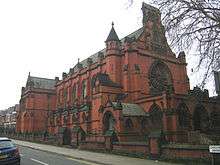Thomas Worthington (architect)


Thomas Worthington (11 April 1826 – 9 November 1909) was a 19th-century English architect, particularly associated with public buildings in and around Manchester. Worthington's preferred style was the Gothic and his building designs were often similar.
Early life
Worthington was born in Crescent Parade, Crescent, Salford, Lancashire, on 11 April 1826. He was the fourth of six sons of a Salford Unitarian cotton merchant, also called Thomas, and his second wife Susanna (1792–1869). He left school, aged 14, and was articled to Henry Bowman, architect (Bowman & Crowther).[1] Before he was twenty he had won two medals: one for a church design (Royal Society of Arts) and one for an essay on "Brick" (Royal Institute of British Architects).[2] After completing his articles in 1847, he assisted William Tite who was building Carlisle railway station but on the suspension of this work he went, in 1848, on an eight-month study tour to France, Italy and Switzerland accompanied by a friend, Henry A. Darbishire.[3] Their journey took them through Tuscany, Latium and Campania; Worthington's notes and sketches from the trip provided him with a first-hand knowledge of Italian Gothic and Renaissance architecture, which provided him with inspiration for his own later work.[2][4]
After returning to Manchester in October 1848, Worthington spent a short time gaining experience of quantity surveying, before opening his own architectural practice in King Street the following year.[4]
Social concerns
Worthington was strongly influenced by his Unitarian upbringing, becoming committed to social reform and improvement and joining numerous learned societies, including the Manchester Literary and Philosophical Society, the Portico Library and the Royal Manchester Institution.
Partly as a result of his social concerns, Worthington was often commissioned to design public buildings, ranging from public baths and hospitals to workhouses and Unitarian churches. These were often designed in a Gothic style, not dissimilar to that of his contemporary and rival Alfred Waterhouse.
Projects in Manchester and district
- Estate Exchange, Overseers and Churchwardens Office, 46 Fountain Street (1852–1859); listed Grade II*
- Greengate Baths, Collier Street (1856)
- Albert Memorial (1862–1867)
- The Memorial Hall, Albert Square (1863–1866)[5]
- City Police Courts, Manchester (1867–1873).
- Chorlton Union Workhouse, afterwards Withington Hospital (1865)
- Prestwich Union Infirmary, afterwards Crumpsall Hospital (1866–1870)
- The Towers, Didsbury (1868–1872), home to Manchester industrialist Daniel Adamson from 1874, this building was later (from 1920) used by the British Cotton Industry Research Association, later called the Shirley Institute
- Brookfield Unitarian Church, Gorton (1870)
- Monton Green Unitarian Church, Monton, Eccles (1875)
- Flowery Field Church, Newton Street, Hyde (1876–1878)
- Ellen Wilkinson High School, Ardwick, formerly Nicholl's Hospital (1879–1880)
- Dovecote, Sale Old Hall (1880)
- Peacock Mausoleum, Gorton (1890)
- Diamond Jubilee Memorial Fountain, Albert Square (1896–1897)
- Dunham Road Unitarian Chapel, Altrincham
Other projects
- Unitarian Chapel, Liverpool
- Garlands Hospital, Carlisle (originally the Cumberland and Westmorland Lunatic Asylum, 1862)
- Wigan Infirmary (1870)
- Sutton Oaks (a country house), London Road, Macclesfield, Cheshire (1875)
- Rosslyn Hill Unitarian Chapel, Hampstead, added north aisle and chancel (1885)
- Manchester College, Oxford (1889–1893)
- Royal Bath Hospital, Harrogate
- Royal Infirmary, Halifax
Legacy
His sons followed in his footsteps, training as architects and working in the family firm, Thomas Worthington & Sons. Hubert, later Sir Hubert Worthington (1886–1963) trained with Sir Edwin Lutyens and was professor of architecture at the Royal College of Art before becoming Slade lecturer in architecture at Oxford University. Percy Worthington (1864–1939), also worked in the family firm.[4]
Thomas Worthington lies buried at the churchyard of the Victorian gothic Brookfield Unitarian Church, Gorton, Manchester.
References
- Notes
- ↑ Some of his drawings appeared in Bowman and Crowther's Churches of the Middle Ages; Stewart, Cecil (1956) The Stones of Manchester. London: Edward Arnold; pp. 80-87
- 1 2 Stewart (1956); pp. 80-87
- ↑ Another pupil of Bowman & Crowther, later the architect of the Columbia Market in Bethnal Green.
- 1 2 3 Archer, John H. G. (2004), "Worthington family (per. 1849–1963)", Dictionary of National Biography, Oxford University Press, retrieved 2009-10-18, (subscription required (help))
- ↑ The Memorial Hall does not commemorate Prince Albert but the constitutional changes of 1662 when the reform of the Church of England under the Commonwealth was undone. For most of its existence it was a base for many local organizations and a venue for meetings.